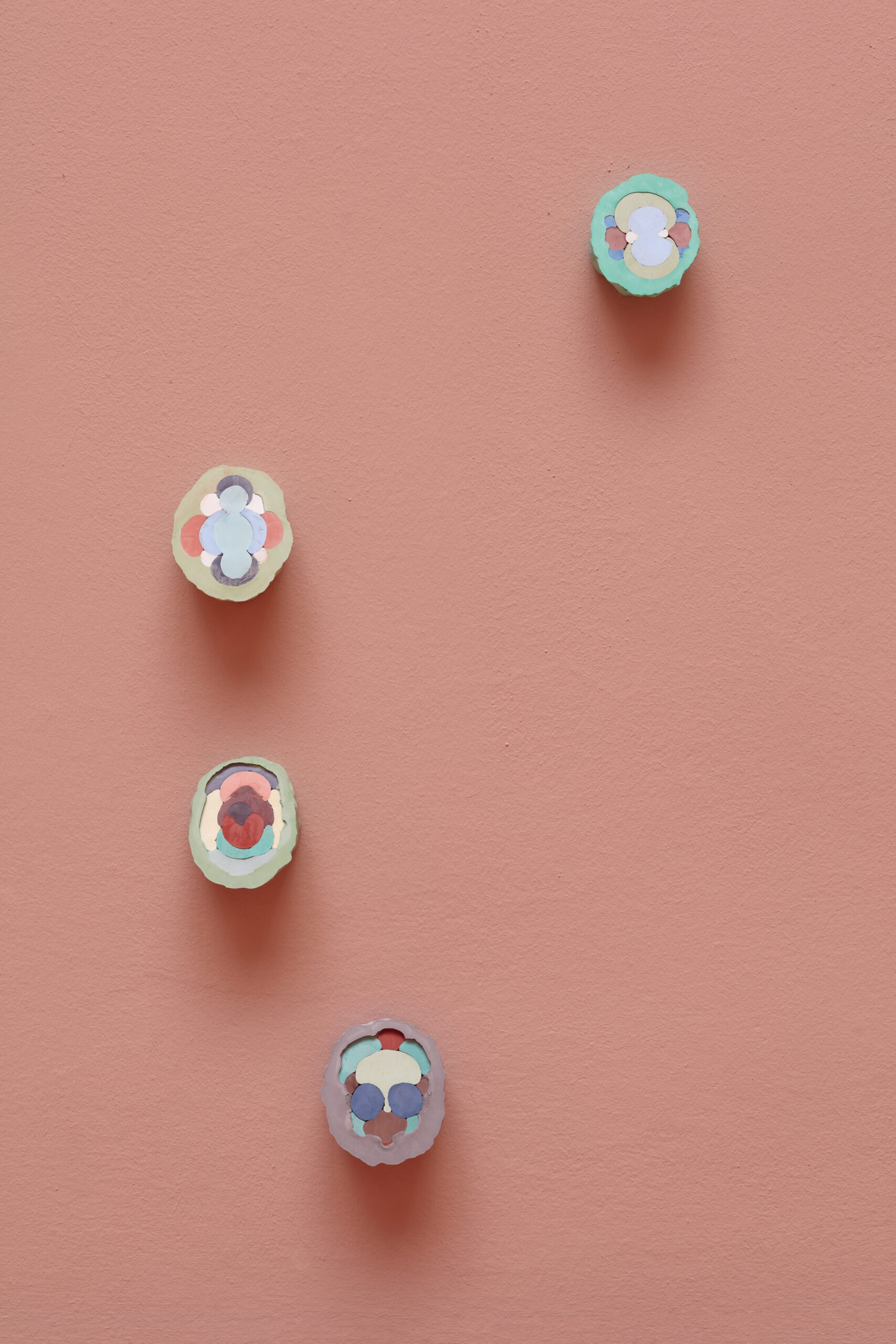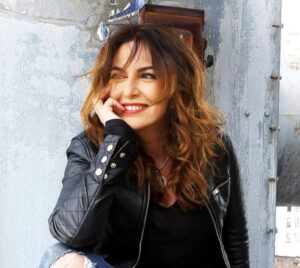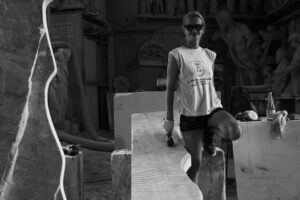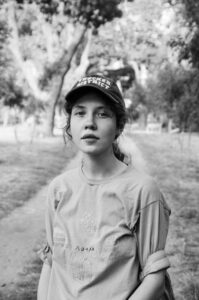Lenka Vítková

– born in 1975 – she is a graduate of the Academy of Fine Arts in Prague (2013) and the Faculty of Arts of Palacký University in Olomouc (1998). She is a member of the rtf collective (with Markéta Lisa). For quite some time, she has been involved in the publication and the production of the Mamka magazine for Contemporary Poetry. In addition to her own exhibitions, she has organised several of her own curatorial projects. Between 2006 and 2010 she actively participated in the management of a space for contemporary art, the Gallery 36 in Olomouc.
After graduating high school in Český Krumlov, I studied at the Department of Czech philology in combination with Art Education at the Faculty of Arts of Palacký University in Olomouc. I could have been around twelve when I began reading books from my father’s library, including works by American writers whose translations had been published here. And it was clear to me that the world was divided and I had no desire to make art here, behind the so-called Iron Curtain. Primarily because of the feeling that I had that there was no communication with the rest of the world and that we were missing out on what was happening in the rest of the world. I perceived this as a large problem, the disconnectedness or detachment, especially present in the domain of fine arts. The revolution happened when I was in high school in my first year. Then, even though I enjoyed math and many other subjects, I began to slowly turn towards art once again. I chose to study philology out of my deep interest in literature. However, I started drawing in the dormitories. I was surrounded by students from the Faculty of Arts who studied art history or languages. Eventually, when I was in my second year, they organised an exhibition of my work in a club. After that, I began working systematically and freely outside of the framework of the school. I graduated with the knowledge that what I wanted to pursue was not teaching but an independent fine art practice. After graduation, I was teaching for seven years1.
I no longer want to hear about what was normal back in the 1990s, things such as that a painting is good since one cannot tell that it was painted by a woman. At the time, the discourse of objectification of women in magazines was horrible. The female body and pornography were ubiquitous in the art of the 1990s. However, in the 90s and at the beginning of the new millennium, I also met the artists whose exhibitions were organised by a friend of mine, Martin Horák. They happened in the gallery of the Music Theater in Olomouc, and among the artists who participated were Ján Mančuška, Josef Bolf, Tomáš Vaněk or Igor Korpaczewski, who had a beautiful exhibition there that incredibly motivated me. These people were also very kind as it was a completely different generation. The artist that deeply influenced me was the painter Jiří Krtička. I could have been able to graduate under his mentorship together with Bronislava Šnajdrová and Daniela Mikulášková. All of us were probably somehow affected by his minimalist approach and his profoundly experienced relationship with nature. The opponent of my diploma work was the exceptional artist, yogi and pedagogue Inge Kosková from Olomouc. During my studies, I also gained some insight into Asian approaches to painting thanks to my friendship with the future sinologist Zuzana Li.
When I came to Prague in 2002, I met the painter Vladimír Skrepl, to whose studio I later enrolled for my doctorate studies between 2010 and 2013. But even before that, I had had a studio in Karlin Studios that was very close to his and there was a certain casual yet fundamental exchange of information happening. My friendship with Patricia Fexová and Sláva Sobotovičová, who had a common studio in Karlín as well, also had a profound impact on me. I still had the feeling that I would like to study further but I also worked full-time in the editorial office of the magazine Umělec [The Artist]. I was writing about art and at the same time, I used to travel to Olomouc to run an exhibition space in the former stand at the Flora fair centre. The communication between the so-called centre and the periphery has been an important topic for me for quite a long time. So eventually, I applied to the Academy of Fine Arts in Prague for a doctoral degree — and it was great because the people in the studio were very interesting and inspiring but mainly because of the ongoing discussions between Vladimír Skrepl and Jiří Kovanda. Through this, I forced to formulate what I was doing… The doctorate redirected me from having a full-time job towards the opportunity to truly pursue art as a viable professional career2.
A number of canvases with distinctive gestural handwriting come from this time after my arrival to Prague, which is still present in my painting, even though it currently hides in the mimicry of monochrome surfaces. The phrase “gestural handwriting” captures the duality of the image and text that is still accompanying me and seems to have strengthened in my work over the years. Intertextuality as intervisuality emerges within these works, for example in the paintings inspired by pansies (2005), which depict the flower and a skull. The topic of the text, or rather the difficulty of writing, appears also in the short video Untitled (2010). My textual and painterly work concerns itself with semiotics, but in recent years I have been influenced by even older methods of connecting pictorial and textual references, namely emblematics, cultivated in fine arts since the Renaissance. In my dissertation, I was searching for the principle of the emblem in the works of contemporary artists, and this influenced my current work as well. For example, the painting Interface (2015) thematises both the essence of the black painting pigment and the alchemical birth of the world from darkness3.
When I started exhibiting works with text, I heard the objection that the texts were too personal. The urgency I demand from myself is for me unattainable without the inclusion of the personal experience. It seems to me that I share this approach with other artists with whom I have established a long-term collaboration — Anne-Claire Barriga and Markéta Lisa. I have recently read an interview with Alexandra Bachzetzis, in which she said that in her opinion the context of visual arts is much more liberal than the context of theatre and dance. I feel the same way about myself — when I discovered that I could write for an exhibition, I was quite relieved that I did not necessarily need the framework of literature and the publishing houses with which I had had the experience as an editor to formulate something. I could just write it on the wall with a piece of chalk.
After the birth of my first child, I abandoned oil painting and started experimenting with different ways of working with tempera emulsions and pigments instead. It seems to me that the silky matte surface of the tempera suits my often abstract paintings more than oil with its illusory potential and magnificent past. And what does feminism mean to me? Feminism is certainly a part of my lived reality. For me, it is a diversity of approaches, a plurality of experiences of one thing. And then there is also my scepticism about the idea of linear progress, that what comes next must be bigger and better. In my work, I tend to delve deeper into the past. I feel like I am always drawing from progressively older sources and older times. Currently, it is the prehistoric paintings, for example. Non-European cultures are also important to me. Openminded approach to otherness and the care for the neglected, perhaps even only from the aspect of humanness, are also transcribed into my own artistic (painting) practice. The sovereignty of the present is one of the power relations that deserves scrutiny4.
The text was created in collaboration with Eva Skopalová (2021).
1Image: Lenka Vítková, Oko Eye, 2016, tempera on canvas, 60 x 70 cm, photo Lukas Jasansky. Courtesy of the artist.2Image: Lenka Vítková, Prsten Ring, 2016, tempera on canvas, 180 x 180 cm. Courtesy of the artist.
3Image: Lenka Vítková, Hlava Head 1, 2015, tempera on canvas, 60 x 50 cm. Courtesy of the artist.
4Image: Lenka Vítková, When at UNPLUGGED exhibition, 2020, Courtesy of the artist.
– narozena 1975, je absolventkou pražské Akademie výtvarných umění (2013) a Filozofické fakulty Univerzity Palackého v Olomouci (1998). Je členkou skupiny rtf (s Markétou Lisou). Dlouhodobě se podílí na vydávání a produkci časopisu Mamka pro současnou poezii. Mimo své vlastní výstavy uspořádala několik vlastních kurátorských projektů a mezi lety 2006-2010 se podílela na vedení olomoucké galerie 36, prostoru pro současné umění.
Po gymnáziu v Českém Krumlově jsem vystudovala na Filozofické fakultě Palackého univerzity v Olomouci obor česká filologie – výtvarná výchova. Asi od dvanácti let jsem začala číst knihy z otcovy knihovny, mimo jiné i od amerických spisovatelů, které u nás vycházely v překladech. A bylo mi jasné, že svět je rozdělen a neměla jsem chuť dělat umění tady za takzvanou železnou oponou. Především kvůli pocitu, že tu není komunikace se zbytkem světa a uniká nám, co se ve světě děje. Tohle jsem cítila jako velký problém, tu nepropojenost nebo nenapojenost, a zvláště ve výtvarném umění. Revoluce přišla, když jsem byla na gymnáziu v prvním ročníku. Potom už, i když mě bavila matematika a mnoho dalších věcí, jsem se k umění pomalu obracela. Vybrala jsem si studium filologie ze zájmu o literaturu, nicméně na kolejích jsem začala malovat. Byli tam se mnou studentky a studenti z filozofické fakulty, kteří studovali dějiny umění nebo jazyky. Nakonec mi ve druháku uspořádali výstavu v jednom klubu. Pak už jsem se tomu věnovala soustavně a volně mimo školu. Diplomovala jsem s vědomím, že se chci věnovat volnému umění, nikoli učení. Učila jsem sedm let1.
Už nechci slyšet to, co bylo normální v 90. letech, že tedy ten obraz je dobrý a vůbec není poznat, že to namalovala holka. Tenkrát ten diskurz zpředmětnění žen v časopisech byl příšerný, ženské tělo a porno bylo v umění 90. let všudypřítomné. V 90. a nultých letech jsem se ale také potkávala s umělci, kterým můj kamarád Martin Horák dělal v Olomouci výstavy v galerii Divadla hudby, a tam třeba vystavoval Ján Mančuška, Josef Bolf, Tomáš Vaněk, Igor Korpaczewski tam měl krásnou výstavu, mě tohle hrozně motivovalo. Tihle lidé byli také velmi laskaví, už to byla jiná generace. Na výtvarce mě hodně ovlivnil malíř Jiří Krtička, u kterého jsem mohla diplomovat, společně s Bronislavou Šnajdrovou a Danielou Mikuláškovou. Asi nás všechny nějak zasáhl jeho minimalismus a hluboce prožívaný vztah k přírodě. Oponentkou mojí diplomky byla výjimečná olomoucká kreslířka, jogínka a pedagožka Inge Kosková. Zároveň jsem během studia získávala vhled do asijských přístupů k malbě díky přátelství s budoucí sinoložkou Zuzanou Li.
Když jsem v roce 2002 přišla do Prahy, seznámila jsem se s malířem Vladimírem Skreplem, u něhož jsem později studovala doktorát mezi lety 2010–2013. Už předtím jsem ale měla atelier v Karlin Studios blízko Skreplova a probíhala tam určitá nenucená, ale zásadní výměna informací. Velký vliv na mě mělo také přátelství s Patricií Fexovou a Slávou Sobotovičovou, které měly v Karlíně společný atelier. Stále jsem měla pocit, že bych ráda studovala, ale také jsem pracovala na plný úvazek v redakci časopisu Umělec. O umění jsem psala a zároveň jsem jezdila do Olomouce provozovat výstavní prostor v bývalém stánku na výstavišti Flora. Tahle komunikace mezi takzvaným centrem a periferií byla dlouho mým důležitým tématem. Nakonec jsem podala přihlášku na Akademii výtvarných umění na doktorské studium – a bylo to skvělé, jednak byli v ateliéru velmi zajímaví a inspirativní lidé a také kvůli stále probíhající diskusi mezi Vladimírem Skreplem a Jiřím Kovandou ve vedení atelieru. Byla jsem jimi prostě nucena formulovat, co dělám… Doktorát mě přesměroval od zaměstnání na plný úvazek k možnosti se umění skutečně věnovat profesionálně2.
Z doby po příchodu do Prahy pochází řada pláten s výrazným gestickým rukopisem, který je v mé malbě stále přítomný, byť na sebe v současnosti bere mimikry monochromních ploch. Spojení „gestický rukopis“ vystihuje podvojnost obrazu a textu, která mě stále provází a jako by v průběhu let v mých pracích sílila. Dostává se do nich intertextualita jako intervizualita, např. v malbách inspirovaných květy macešek (2005), které zobrazují květinu i lebku. Téma textu, respektive obtížnosti psaní, se objevuje v krátkém videu Bez názvu (2010). Má textová i malířská tvorba pracuje se sémiotikou, ovšem v posledních letech mě ovlivnily ještě starší metody propojování obrazového a textového sdělení, a sice emblematika, pěstovaná ve výtvarném umění od renesance. V dizertaci jsem nalézala princip emblému v dílech současných umělců, emblematika ovlivnila i mou současnou práci. Například obraz Rozhraní (2015) tematizuje jak podstatu malířského pigmentu (černou barvu), tak alchymistické zrození světa z temnoty3.
Když jsem začala vystavovat textové práce, slyšela jsem námitku, že ty texty jsou příliš osobní. Naléhavost, kterou sama po sobě požaduji, je pro mě ale bez zahrnutí osobní zkušenost nedosažitelná. Zdá se mi, že tenhle přístup sdílím s dalšími umělkyněmi, se kterými dlouhodobě spolupracuji – s Anne-Claire Barrigou a s Markétou Lisou. Nedávno jsem četla rozhovor s Alexandrou Bachzetzis, kde říkala, že kontext vizuálního umění je pro ni mnohem svobodnější než kontext divadla a tance. Cítím to u sebe podobně – když jsem objevila, že jsem schopna psát do výstav, dost se mi ulevilo, že k tomu, abych něco formulovala, nepotřebuju nutně kontext literatury a nakladatelský provoz, se kterým jsem měla zkušenost jako redaktorka. Můžu to prostě napsat křídou na zeď.
Po narození prvního dítěte jsem opustila olejomalbu a místo toho jsem začala experimentovat s různými způsoby práce s temperovými emulzemi a pigmenty. Připadá mi, že hedvábný mat temper mým často abstraktním obrazům svědčí víc než olejomalba s jejím iluzivním potenciálem a velkolepou minulostí. A co je pro mě feminismus? Feminismus je určitě součást mojí životní reality. Je to pro mě diverzita přístupů, pluralita prožívání jedné věci. Pak je tu také moje skepse k lineárnímu vývoji, že to, co přijde, musí být větší a lepší. Já sama se ve své tvorbě spíše zavrtávám hlouběji do minulosti. Mám pocit, že čerpám stále ze starších a starších dob. Třeba teď jsou to pravěké malby. Nebo jsou pro mne důležité neevropské kultury. Otevřený přístup k jinakosti, resp. k péči o přehlížené, se tak snad z čistě lidských úrovní propisuje i do mé vlastní umělecké (malířské) praxe. Svrchovanost současnosti je jedním z mocenských vztahů, který si zaslouží kritiku4.
Text vznikl ve spolupráci s Evou Skopalovou (2021).
1Obrázek: Lenka Vítková, Oko, 2016, tempera na plátně, 60 x 70 cm, foto Lukas Jasansky. S laskavým svolením umělkyně.2Obrázek: Lenka Vítková, Prsten, 2016, tempera na plátně, 180 x 180 cm. S laskavým svolením umělkyně.
3Obrázek: Lenka Vítková, Hlava 1, 2015, tempera na plátně, 60 x 50 cm. S laskavým svolením umělkyně.
4Obrázek: Lenka Vítková, Když, UNPLUGGED výstava 2020. S laskavým svolením umělkyně.



